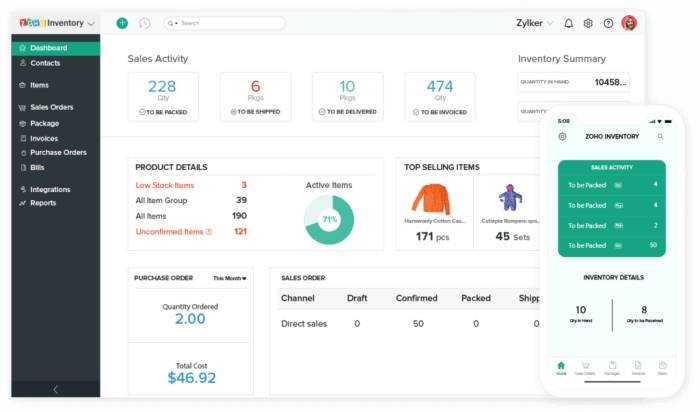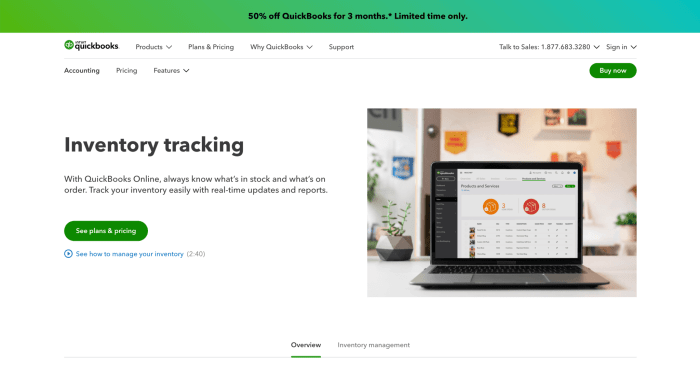Small business software for inventory and sales is crucial for efficient operation and growth. Effective inventory management streamlines stock control, minimizing waste and maximizing profitability. Simultaneously, robust sales tracking provides valuable insights into customer behavior and sales trends, allowing businesses to make data-driven decisions. This combination empowers small businesses to optimize their processes, enhance customer service, and ultimately, boost their bottom line.
The right software can significantly reduce administrative burdens, freeing up valuable time for owners to focus on strategic growth initiatives.

Source: smallbiztrends.com
Choosing the appropriate software involves careful consideration of factors such as business size, industry, and specific needs. Features to look for include inventory tracking (with capabilities like barcode scanning and low-stock alerts), sales order processing, reporting and analytics dashboards, and integration with other business tools like accounting software. A user-friendly interface is also paramount to ensure ease of use and adoption by employees.
Running a small business is demanding. Juggling inventory management, sales tracking, customer relationships, and finances can feel overwhelming. The right software can be the difference between chaotic operations and streamlined efficiency. This comprehensive guide explores the vital role of inventory and sales software for small businesses, outlining key features, benefits, and considerations to help you choose the perfect solution.
Understanding the Need for Inventory and Sales Software
For small businesses, efficient inventory and sales management is crucial for profitability and growth. Manual tracking methods are prone to errors, inefficiencies, and lost revenue. Inventory and sales software offers a centralized system to:
- Track inventory levels: Accurately monitor stock quantities, preventing stockouts and overstocking.
- Manage sales orders: Process orders efficiently, from order placement to delivery.
- Generate reports: Gain valuable insights into sales trends, inventory performance, and customer behavior.
- Improve customer relationships: Enhance communication and provide better customer service.
- Reduce operational costs: Streamline processes and minimize manual labor.
- Boost profitability: Optimize inventory levels, reduce waste, and improve sales performance.
Key Features of Effective Inventory and Sales Software
The ideal inventory and sales software solution will adapt to your specific business needs. However, several key features are common to most effective systems:
Inventory Management Features:
- Real-time inventory tracking: Provides up-to-the-minute visibility into stock levels.
- Automated stock alerts: Notifies you when stock levels reach pre-defined thresholds, preventing stockouts.
- Barcode and RFID scanning: Facilitates quick and accurate inventory counting and tracking.
- Lot and serial number tracking: Essential for managing perishable goods or products with unique identifiers.
- Demand forecasting: Predicts future demand based on historical sales data, helping optimize inventory levels.
- Inventory valuation methods: Supports various methods like FIFO (First-In, First-Out) and LIFO (Last-In, First-Out).
Sales Management Features:, Small business software for inventory and sales
- Point of Sale (POS) system integration: Seamlessly integrates with your POS system for accurate sales tracking.
- Order management: Streamlines the order processing workflow, from order placement to fulfillment.
- Customer relationship management (CRM) integration: Manages customer information and interactions, enhancing customer service.
- Sales reporting and analytics: Provides detailed sales data, allowing you to identify trends and make data-driven decisions.
- Sales forecasting: Predicts future sales based on historical data, aiding in planning and resource allocation.
- E-commerce integration: Connects your inventory and sales data with your online store for real-time updates.
Choosing the Right Software for Your Small Business
Selecting the appropriate software depends on several factors, including:
- Business size and complexity: A smaller business may require simpler software, while a larger business may need a more robust solution.
- Industry-specific requirements: Certain industries have unique inventory and sales management needs.
- Budget: Software options range from free or low-cost to enterprise-level solutions.
- Integration capabilities: Consider compatibility with existing systems like your POS, CRM, and accounting software.
- Scalability: Choose software that can grow with your business.
- Ease of use: Select software that is intuitive and easy for your team to learn and use.
Popular Inventory and Sales Software Options
Numerous software solutions cater to small businesses. Some popular options include (note: this is not an exhaustive list and specific features and pricing vary):
- Zoho Inventory: A comprehensive solution offering inventory management, order processing, and reporting features. [ Zoho Inventory Website ]
- QuickBooks Online: While primarily an accounting software, QuickBooks offers robust inventory management features for small businesses. [ QuickBooks Website ]
- Shopify: A popular e-commerce platform with integrated inventory management tools. [ Shopify Website ]
- Square: Provides POS systems with integrated inventory tracking capabilities. [ Square Website ]
- Xero: Another accounting software with inventory management features, particularly useful for businesses that need strong financial reporting. [ Xero Website ]
Implementing and Optimizing Your Software
Successfully implementing inventory and sales software requires careful planning and execution. Key steps include:
- Data migration: Accurately transfer existing inventory and customer data into the new system.
- Training: Provide adequate training to your team on how to use the software effectively.
- Process optimization: Adjust your business processes to take advantage of the software’s capabilities.
- Regular monitoring and maintenance: Continuously monitor the system’s performance and address any issues promptly.
- Regular data backups: Protect your valuable data by regularly backing up your system.
Frequently Asked Questions (FAQ): Small Business Software For Inventory And Sales
- Q: What is the cost of inventory and sales software? A: Costs vary significantly depending on the features, scalability, and vendor. Some options offer free plans with limited features, while others charge monthly or annual subscriptions.
- Q: How long does it take to implement inventory and sales software? A: Implementation time depends on the complexity of the software and your business’s size. It can range from a few days to several weeks.
- Q: Can I integrate my existing systems with new software? A: Many inventory and sales software solutions offer integration with popular accounting, CRM, and e-commerce platforms. Check the software’s specifications to ensure compatibility.
- Q: What kind of training is required? A: Most vendors provide training resources, including tutorials, documentation, and sometimes even live training sessions. The complexity of the training will depend on the software’s features.
- Q: What if I need help with the software? A: Most vendors offer customer support through phone, email, or online chat. Look for vendors with responsive and helpful support teams.
Conclusion
Investing in the right inventory and sales software is a crucial step for any small business aiming for efficiency and growth. By carefully considering your needs and selecting a solution that aligns with your business goals, you can streamline operations, improve profitability, and focus on what matters most: growing your business.
Call to Action
Ready to transform your small business operations? Explore the inventory and sales software options discussed in this guide and find the perfect fit for your needs. Start your free trial or request a demo today!

Source: webxzone.com
In conclusion, investing in the right small business software for inventory and sales is a strategic move that offers significant returns. By streamlining operations, improving data visibility, and empowering data-driven decision-making, businesses can gain a competitive edge. The key is to carefully evaluate available options, considering specific needs and future scalability, to find a solution that fosters growth and efficiency.
The right software will not only manage day-to-day tasks but also provide the foundation for sustainable success.

Source: smallbiztrends.com
FAQ Insights
What are the typical costs associated with small business inventory and sales software?
Costs vary widely depending on features, vendor, and subscription model (monthly, annual). Expect to find options ranging from free, limited-feature solutions to more comprehensive packages costing hundreds of dollars per month.
How can I ensure data security with this type of software?
Look for software with robust security features such as encryption, data backups, and access controls. Read reviews and check vendor security certifications to assess their commitment to data protection.
What kind of training is needed to use this software effectively?
Many vendors offer training resources, including tutorials, webinars, and online help documentation. The ease of learning will depend on the software’s user interface and complexity of features. Some software providers offer onboarding support.
Can this software integrate with my existing accounting software?
Many inventory and sales software solutions offer integrations with popular accounting platforms. Check for compatibility with your current accounting system before making a purchase.